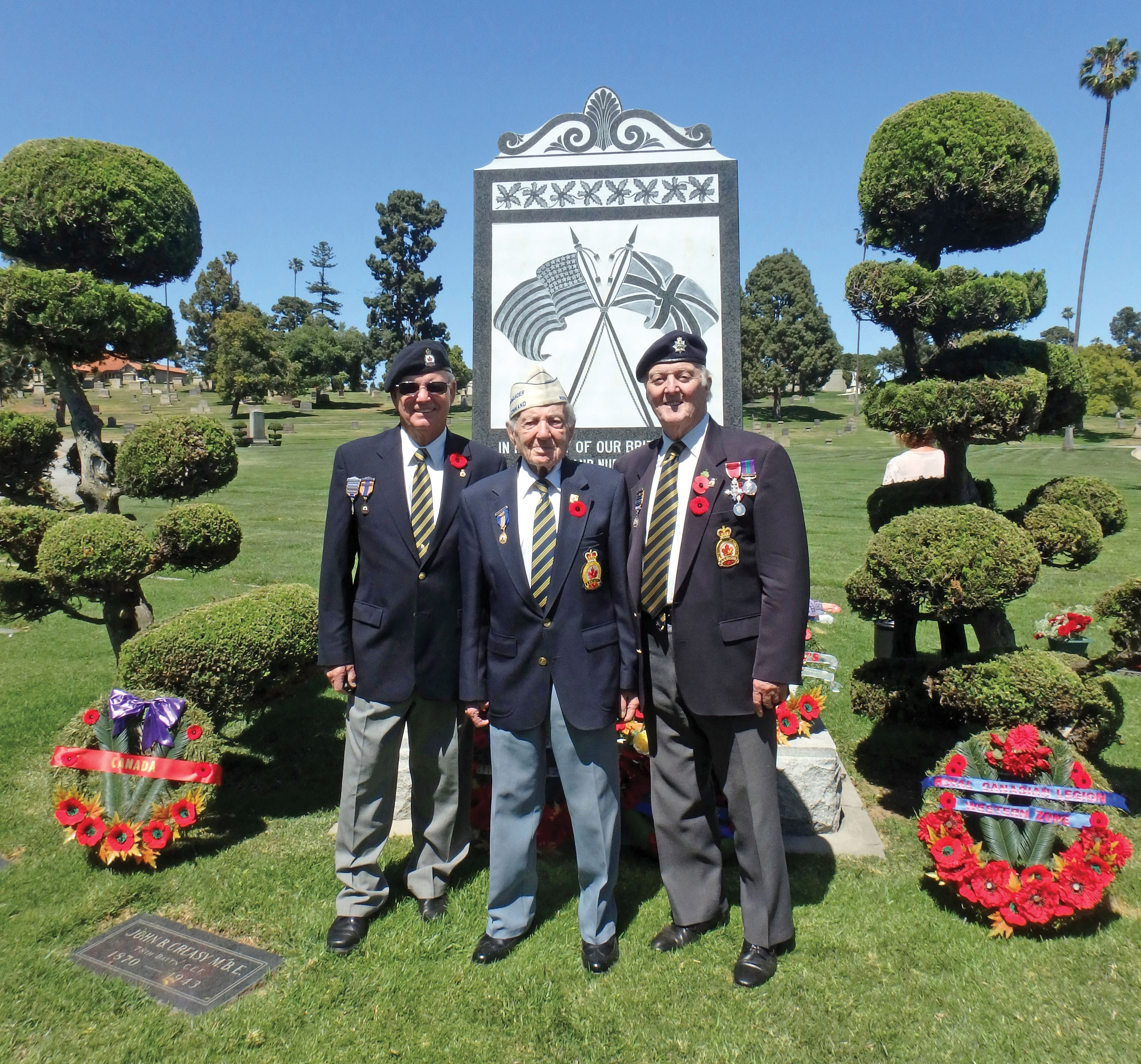
Western U.S. Zone executive members (from left) Douglas Lock, Charles Brechin and Robert Edmonds stand by the cenotaph at Inglewood Park Cemetery. [Caroline Brechin]
Strolling through the Inglewood Park Cemetery, east of Los Angeles, in 2003, Charles Brechin, then the president of California Branch of The Royal Canadian Legion in Vista, California, struck up a conversation with a cemetery groundskeeper. He was told that “about six” Canadian veterans were buried nearby in unmarked graves.
Brechin asked for a list of veterans in unmarked graves, but the cemetery administration was unable to provide one. Then in 2009, Western U.S. Zone Secretary Douglas Lock, at Brechin’s request, renewed the challenge of securing the list.
Lock was determined to get the task completed and soon a cemetery employee, Joan Francis, was assigned and the search for names began. By the following year, a list of 202 names was available. Further investigation by Legion members raised the total to 227 unmarked graves of British and Canadian veterans from the First World War and the Second World War dating from 1923. The executive was astounded at the number and felt it was essential that the veterans’ resting places be identified.
However, funds for more than 200 individual markers far exceeded the financial resources of the zone. Instead, the zone thought that a single plaque to honour all those resting in unmarked graves would be appropriate.
Many Commonwealth veterans moved to California after the First World War, attracted by the weather and well-paying jobs. Another wave of veterans came after the Second World War, when there was plenty of work in aircraft plants and shipbuilding yards. The U.S. economy was booming and many Canadians settled there and raised families. British veterans came to escape continued wartime rationing and a struggling economy.
While working on wording for the plaque, Lock connected with the Last Post Fund in Canada. In 2011, the Last Post Fund began working with the Commonwealth War Graves Commission to help verify names and service records of the Canadians buried in unmarked graves at the cemetery. The Last Post Fund, a charitable organization created to ensure that veterans have a dignified burial and marker, will erect headstones for Canadian veterans whose graves have been unmarked for more than five years.
This work continued and in 2014 the ordering of headstones began. During the following year, the first group were set in place. In total, 124 Canadian veterans buried at the cemetery now have marked graves. Some of the ground-level stones include several names, as the ashes are buried together in one plot.
One newly marked grave is that of David Stewart, who served with the 37th Artillery Battalion in the Canadian Expeditionary Force in the First World War. His granddaughter, Sharon Shambaugh, knew where he was buried but his name was not included on an existing marker. Unable to modify that marker, the Last Post Fund had a new stone installed that includes Stewart’s name. Shambaugh attended the 2017 Memorial Day ceremony and saw that her grandfather’s grave is now marked.
One hundred unmarked graves remain at Inglewood Park Cemetery. Still to be honoured are about 70 British veterans because no organization like the Last Post Fund exists in Britain. If a British group does not step forward, a plaque honouring all British veterans buried in unmarked graves at the cemetery will be erected.
Western U.S. Zone Commander Robert Edmonds has been involved with the veterans’ section at Inglewood Park Cemetery since 2003, when Britain handed over management of its veterans’ graves to the Legion’s Western U.S. Zone. Britain had purchased cemetery plots in the 1920s and ’30s for veterans’ use, a project formerly managed by Britain’s consular office in Los Angeles. Today, Edmonds continues to authorize interment of Canadian and British veterans at Inglewood.
Advertisement





















